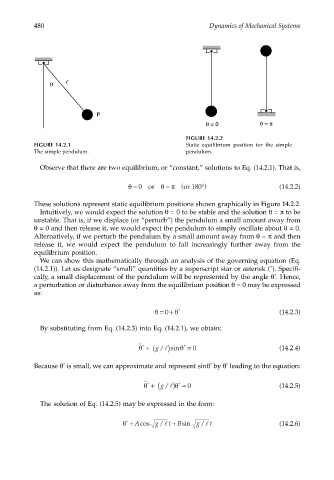Page 499 - Dynamics of Mechanical Systems
P. 499
0593_C14_fm Page 480 Tuesday, May 7, 2002 6:56 AM
480 Dynamics of Mechanical Systems
θ
P
θ = 0 θ = π
FIGURE 14.2.2
FIGURE 14.2.1 Static equilibrium position for the simple
The simple pendulum. pendulum.
Observe that there are two equilibrium, or “constant,” solutions to Eq. (14.2.1). That is,
θ = 0 or θ = π (or 180 °) (14.2.2)
These solutions represent static equilibrium positions shown graphically in Figure 14.2.2.
Intuitively, we would expect the solution θ = 0 to be stable and the solution θ = π to be
unstable. That is, if we displace (or “perturb”) the pendulum a small amount away from
θ = 0 and then release it, we would expect the pendulum to simply oscillate about θ = 0.
Alternatively, if we perturb the pendulum by a small amount away from θ = π and then
release it, we would expect the pendulum to fall increasingly further away from the
equilibrium position.
We can show this mathematically through an analysis of the governing equation (Eq.
(14.2.1)). Let us designate “small” quantities by a superscript star or asterisk ( ). Specifi-
*
*
cally, a small displacement of the pendulum will be represented by the angle θ . Hence,
a perturbation or disturbance away from the equilibrium position θ = 0 may be expressed
as:
θ =+ θ * (14.2.3)
0
By substituting from Eq. (14.2.3) into Eq. (14.2.1), we obtain:
)
*
˙˙* / sinθ = 0 (14.2.4)
l
θ + (g
*
*
*
Because θ is small, we can approximate and represent sinθ by θ leading to the equation:
˙˙* / θ ) l * = 0 (14.2.5)
θ + (g
The solution of Eq. (14.2.5) may be expressed in the form:
+
*
l
l
θ + A cos g / t B sin g / t (14.2.6)

